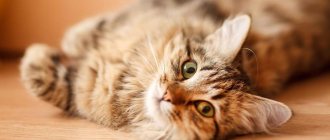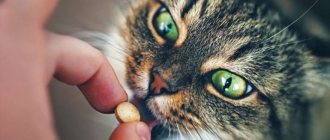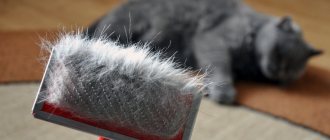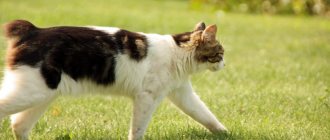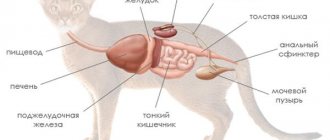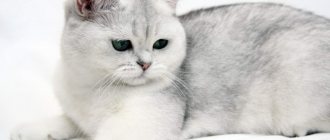History of Pied Pipers
The domestication of cats occurred in Egypt approximately 9 thousand years BC. e. In those days, the grain harvested from the fields was eaten by mice and rats. People saw how cats hunted them and began to lure and tame the nimble hunters. Since then, these animals have taken their place next to people, ridding them of rodents. For such merits, cats were called sacred animals, protecting food supplies and saving people from hunger. Since ancient times, cats have been given special honors, and high fines were imposed for killing them. The cost of a clever rat-catcher cat was equal to the cost of an ox.
Agile rat-catching cats in the old days were worth as much as an ox
There is a legend that says that during the global flood, rodents appeared on Noah’s Ark, dangerous to the inhabitants. Then cats were born from the lions, destroying all the rodents and saving the animals on the ship from them.
Cats conscientiously performed their duties in peasant homes, in monasteries, and at the royal court. Peter I ordered the adoption of cats to protect barns from the invasion of mice and rats. By order of Elizabeth, his daughter, 30 rat-catcher cats were brought to the Winter Palace from Kazan, the city where the most dexterous rat-catchers were believed to live. During the reign of Catherine II, cats appeared in the Hermitage to protect works of art from rodents.
During the siege of Leningrad, cats saved residents and the city itself 2 times. When, in the first years of the siege, all the animals were eaten due to hunger, many rodents appeared in the city, and the Winter Palace was simply swarming with them. To combat dangerous rodents, 5 thousand smoky cats were brought from Yaroslavl to Leningrad in April 1943, then a train of Siberian cats arrived, and soon rodents disappeared from the city.
Cats still regularly serve in the Hermitage, protecting the country’s cultural heritage from rodents and forming an integral part of museum life; they are its unique symbol. Museum employees say that throwing cats out into the street is like throwing a painting by an outstanding artist from the 10th floor.
Cats in the Hermitage protect the country's cultural heritage from rodents
Tailed liberators of Leningrad
When all the cats in the besieged city were eaten in 1943, rats began to multiply at a catastrophic rate. They ran through the streets like a businessman in search of corpses, climbed into apartments, destroyed furniture and the last supplies.
The rodents were shot by special brigades and crushed by tanks, but the “rat troops” did not retreat. The city was saved by rat-catching cats of Russian and Siberian breeds. They were brought in trains from all over the country after the blockade was broken.
Today, two sculptures remind us of the four-legged liberators. One depicts the cat Vasilisa standing on the ledge, the second depicts the cat Elisha sitting opposite. St. Petersburg residents believe that whoever throws a coin on a cat pedestal will be lucky.
We invite you to read: Heatstroke in cats: symptoms, treatment and prevention - Cat Health
General features of rat catchers
The rat catcher is not a separate breed of cat, it is the valuable quality of the animal, the sharpness of its hunting instinct. According to felinologists (specialists in breeding cats), rat-catching cats can be identified by the following characteristics:
- muscular body, powerful jaws, strong legs;
- head shape - there is a relationship between the genes responsible for the instincts of hunters and the genes that determine the configuration of the skull of cats: rat-catching abilities are observed in animals with a triangular head (oriental type of cats);
- lush mustache and high ears with tassels at the ends: they allow animals to detect possible rustles, and this is very important for a successful hunt.
Ratcatcher cats usually have large ears that can detect the smallest noises.
Some rat hunters may be affectionate in nature, while others may be unsociable. There are animals that want to please their owner and often catch rats to show him their love. And there are cats that avoid people and do not welcome affection, but this is also quite normal.
What kind of rat exterminator is he?
The Pied Piper is not a cat breed, as many people think, but a rare and valuable quality. Most often it occurs in outbred yard cats. Not spoiled by their owners, adapted to harsh street conditions, they walk wherever they want and retain a keen hunting instinct.
Experts in the meowing family name 5 signs by which you can recognize a future rat catcher in a kitten:
- family tradition: if the cub has a mother and father (or one parent) who are rat catchers, by the age of 4 months they will pass on hunting skills to him;
- belonging to the female sex: cats are naturally more active and bolder than cats (this is due to maternal readiness to protect offspring and to the ancient hunting ritual of cats, obliging the female to attack the victim (the male joins if the prey is large and “male help” is required);
- zeal in play: if a kitten grabs an impromptu mouse - a bow or a toy - with its teeth, and not with its paw, it should grow into a rat-catcher cat;
- tricolor coat: popular rumor calls this feature a marker of a born hunter (geneticists do not comment on this observation);
- morphological features: muscular body, strong legs, powerful jaws, large ears with sharp tips.
The listed signs are only a natural given. Whether it will be implemented depends on the conditions of keeping and raising the four-legged purr. However, amateurish advice “not to feed” can lead to an unexpected result: the unfortunate pet will begin to hunt for the trash can and hang around in garbage dumps.
Breeds of rat-catching cats
There are certain breeds in the cat family, whose representatives are distinguished by excellent health, special dexterity and dexterity in catching rats.
Siberian cat
The cat was named Siberian due to its fluffy long hair. She is unpretentious, has a strong build, the weight of cats reaches 7 kg, cats weigh about 9 kg. She has strong paws and excellent grip. Due to the slightly longer hind legs compared to the front legs, the cat has the ability to run and jump quickly. Such animals are obstinate in nature, they have an excellent reaction, which is necessary when catching rats. They are independent and love freedom.
The Siberian cat has a strong build and excellent grip.
To maintain the desired shape, Siberian cats require regular walks in the fresh air.
Maine Coon
Cats of this breed are distinguished by mobility and strength. Maine Coons are hardy and able to live in regions with harsh climatic conditions. These large animals (males can weigh up to 15 kg) have the nature of a predator; they do not welcome human affection. Due to their size, they can easily deal with rats.
Maine Coons easily deal with rats
This breed of cat is distinguished by straight-set large ears, which have tassels at the ends. Maine Coons have long and thick fur. They have well-developed muscles, a wide chest, strong bones, and a thick and long tail. All this data allows Maine Coons to become a real threat to rodents.
Kurilian Bobtail
A feature of animals of this breed is a short tail, the length of which does not exceed 3–8 cm. But they have strong hind legs, which are longer than the forelimbs. And therefore the Kurilian bobtail runs well, jumps, and deftly strangles rats. Males of this breed weigh about 10 kg, females - 6 kg.
The Kurilian Bobtail is fearless and deftly strangles rats
Such cats are capable of completely destroying a mouse or rat hole. They are easy to train and can be trained. People keep them as companions; they get along easily with other animals. Bobtails have a fearless character.
European shorthair cat
Representatives of this breed destroyed rodents back in the days of Ancient Rome. European shorthair cats are called yard cats and are not considered purebred. However, they are popular in the world and are one of the best rat catchers. The predator's passion and agility help them successfully hunt rats and mice.
European shorthair cats are some of the best rat catchers.
Such cats are distinguished by individuality, independence, grace, and aristocratic appearance. They have a short coat, gray or silver marbled in color.
European cats get along well with people and are non-aggressive. They love to play, but do not completely obey their owner.
Cymric
Animals of this breed are similar to ordinary cats, but with a short tail. This structure, along with agility and tenacious claws, makes the Cymric a successful rat catcher.
Agility and tenacious claws make the Cymric a successful rat catcher.
It is good to keep these cats in private homes with open areas, as the animals require regular walks in the fresh air, freedom of movement, and physical activity.
British Shorthair
The hunting instinct and excellent natural inclinations make the British excellent rat catchers. Such cats are calm, friendly, and attractive in appearance. They love to please their owner by bringing him a caught rodent in their teeth in order to exchange it for rewards and something tasty.
Natural inclinations and hunting instinct make British Shorthairs excellent rodent catchers.
Females, weighing an average of 4 kg, try not to attack large rats, hunting only young ones or mice. Often this is enough to avoid a rodent infestation.
Russian blue
Russian blue cats are medium in size and light in weight, but this does not interfere with their hunting habits. Instant reaction and silent movement for a long time make these cats good rat catchers.
The Russian Blue cat has the ability to move silently and react instantly.
The ability of the Russian Blue to react to rodents is a true art: its speed of attack on the prey, accuracy and grace of movements are captivating. This is a thunderstorm of super rats, weighing about 500 g. The Russian Blue does not like partners of other cat breeds, but gets along well with rat catchers of its own breed.
Opponent of tenderness from the owner.
Cymric
Known for its unusual appearance, the cat also copes well with the craft of a hunter. According to breed standards, the cat’s tail is “chopped off”, but the legs, on the contrary, are gracefully long. The fast Kymrik will easily overtake even the most nimble victim, and his tenacious paws will finish what he started. One of those breeds that are not boring to the eye and at the same time perfectly suitable for our conditions. Basically, these cats like to live in private homes. There is more loot here and there is room to run.
Features of care and maintenance
A real rat catcher can be raised from a small kitten. You just need to use some tips:
- To maintain the hunting instinct, the animal should be given food in small portions at least 5-6 times a day. To prevent the cat from becoming lazy, it should not be overfed. Food should not be in the bowl all the time, but the cat should not be left hungry either, since the rat hunter will need strength to attack the rodents.
- It is necessary to cultivate a hunting sense in the future rat catcher, praise and encourage him for any prey he catches: a bird, a mouse, a fly.
- It is difficult for a person to raise a kitten to be a rodent hunter, and therefore there is no need to separate it from its mother cat for up to 5 months so that during this time she can teach him the necessary skills.
- The pet must lead an active lifestyle; it requires not only toys in the form of balls, mice, bows, but also special play complexes.
The gaming complex will help your pet maintain an active lifestyle
- Rat catchers need to be vaccinated against rabies to boost their immunity, since rats are aggressive animals. When cats receive wounds from rodents, the damaged areas must be carefully treated and consulted with a veterinarian.
Otherwise, the care and maintenance of rat catchers is no different from the care of ordinary cats.
Sports French
Chartreux cats have a beautiful athletic build, which helps them greatly in catching rodents. Pets are very affectionate and domestic, they get bored in the absence of their owners. To avoid this, it is enough to get a purebred Chartreuse friend or girlfriend. Then all mice are guaranteed to leave the house forever.
Having become acquainted with such various breeds of rat-catching cats, it is quite possible to find a suitable pet for yourself and at the same time get rid of annoying rodents.
Ratcatcher cats for rent: where to find, cost
Buying a real rat catcher is quite difficult: you can be deceived for a lot of money. However, in some cities it is possible to rent a cat. You should know that ratcatcher cats are available for rent from breeders, many specialized nurseries, and animal and pet supply stores. After the rats are killed, the animal is returned.
For a cat, being in a new place with unfamiliar people can be stressful, so you cannot be sure that in such an environment he will catch rodents.
You can rent a ratcatcher cat
For this purpose, you can find a rat-catcher cat via the Internet, using message boards, for example, the site for finding part-time jobs YouDo, or specialized forums. There is no fixed price for such services; sometimes it is set depending on the cost of the cat itself. Typically, the price of such a service varies from 500 to 3 thousand rubles.
Forum participants generally have a negative attitude towards giving their animal to catch rats, since no one wants to create a stressful environment for the cat, and besides, this can be dangerous: the rats may already be poisoned.
Maine Coon
A dignified resident of a wealthy suburb. Copes well with minor troubles in the form of rodents. By the way, our Barsik is similar to this animal in color and length of fur. However, he is far from the size of a real representative of this breed. And this is not surprising, because the male can reach 15 kilograms. Despite its large size and predatory disposition, it is friendly even with strangers. However, at the same time, you should not take the initiative to pet him; let the king decide for himself when he needs to be petted.
Who is better at catching mice, a purebred cat or a barn cat?
Both purebred and barn cats have this instinct in the same way. In more reliable hunters it is better expressed. If we consider a purebred cat, then in the course of their evolution, breeders tried to lull the cats’ natural instincts in order to better adapt them to life in an apartment. Therefore, such a cat will catch a mouse, but only out of curiosity, and not in order to eat or kill it.
However, this does not mean that outbreds catch mice better. Especially if they were bred in apartment conditions and have never seen rodents. And even if such a cat does come across a rat or mouse, it will simply play with it, not suspecting that a real hunter should bite it in the back of the head to kill it. And good hunting requires skills.
How to teach or instill in a cat the ability to catch rodents well?
An experiment conducted back in 1960 will help answer this question. In which four cats took part: two purebred and two ordinary hunters. All cats were bred with cats similar to them. After the litter appeared, the kittens were changed, the hunter-murks were given purebred ones, and the purebred ones were given ordinary ones.
After three weeks of age, ordinary hunting cats brought a mouse to “their” kittens and taught them to handle it with special care and precision. At this time, ordinary kittens from “their” purebred mothers learned only games, hunting was absent from their lives
During the experiment, it became clear which cats would be the best hunters - those that lived in special conditions and had experience in catching mice. Therefore, with all the cat's heredity, growing conditions play a key role.
This means that in order to choose a mouse exterminator, you need to know how the kittens were kept.
A kitten from the street or born in a basement is very suitable for this role; from three to five months of age it is already ready and has all the necessary skills for hunting.
If we talk about purebred representatives, then you need to know in what conditions they were raised - if in a suburban area with access to the street, and not in an aviary, then the following breeds are well suited: Russian Blue, Siberian, Kuril Bobtail, Bogatyr - Maine Coon, Bengal .
Appearance of the ratcatcher cat
Which cats are better at catching, judging by their appearance?
Short-haired representatives are considered the best hunters, because with a little rain, the long hair gets wet and begins to smell strongly, which scares off potential prey. And the wool should be appropriately colored: dim stripes and spots, i.e. wild color, it’s easier to blend in with the world around you.
If the pattern is monochromatic, then not bright colors will do: it will not be easy for a white cat to catch a mouse, but for a red, gray, or black cat it will be easier to merge with nature. Our grandparents also say that the more mustachioed the cat is, the more he will catch.
By gender
The sexual instinct of cats interferes with the hunt a little; he would like to find another bride for himself, that’s what’s first in his head. Cats come into heat almost every month. If she gave birth to kittens, she devotes almost all her time to them. But then he is an excellent hunter. Therefore, the cat is probably more diligent, more diligent, and more successful than the cat. And if she is also sterilized, then this is generally wonderful, less thoughts about offspring and walking, more about hunting. Castration of a cat will also correctly influence the right thoughts about hunting, although if before castration he did not particularly like to run after rats, then after that he may not wake up particularly zealous.
Hunger is not a thing...
Why does a cat catch mice? Well, probably to eat? It turns out that if the cat is not fed, it will catch better and catch more? Logical, but not correct. Cats do not catch mice for food. Regardless of whether she is full or not, she will catch the same. For her, fishing is not a way of subsistence, it is something like a game. She needs the fishing procedure itself. And eating is already a nice bonus to the game. By the way, they love simple mice, but they simply kill moles and rats.
Beware the mouse is poisoned
A cat that catches mice every day is at risk of contracting viruses and parasites carried by rodents. Therefore, the owner of a rat-catcher cat should not skimp on vaccinations and other preventive measures.
Apartment trappers are also at risk: the mouse can be poisoned by arsenic or other poison, which can lead to severe poisoning or even death. Allow your cat to eat the mouse only if you are sure of its “purity”.
Bright representative
Larry the cat, who lives in the UK, is considered one of the best rat catchers. He “works” on the prime minister’s working staff and specializes exclusively in catching court rats. Larry the Cat is the main rat catcher, who began his work in residence in February 2011. The need to have a cat on staff that would be great at catching rats arose after several unpleasant incidents. During a television report, a rat ran in the background. All of England then learned what unpleasant neighbors the Prime Minister had.
Of course, the building was immediately “cleaned” and rodent control specialists were hired. In the end, it turned out that no one could handle this matter better than the cat. Now Larry the cat is the main rat catcher of the kingdom, pride and good friend. We adopted a kitten from a pet shelter. The nursery said that he is the best hunter, because he grew up on the street and has been getting his own food since childhood.
But how can one identify among the many breeds the one that is destined by nature to skillfully hunt mice? How to recognize a future threat to the mouse community in a small fluffy ball? Let's try to figure it out.
Appearance
If, when choosing a pet, you are guided not by the breed, but by appearance, then you should pay attention to several indicators. The appearance of the kitten plays an important role. Try to take large babies with large massive paws and a long tail. Representatives of flimsy, small breeds will simply be afraid to engage in a fight with a rat that is larger than them.
The second point is wool. If you need a reliable rat-catcher cat at home, then it is better to focus on short-haired individuals. If the cat has long hair, then in damp weather the cat smell will be stronger. Consequently, rodents will quickly sense the approaching hunter and run away, leaving him with nothing.
Take your pet and watch him play. What does a ratcatcher cat look like as a child? Even as a kitten, he will grab his toy prey with his teeth and hold it tightly, without letting go. An animal that will only timidly play with a toy, touching it with its paws, will not become a real hunter, don’t even dream about it.
Gender question
Cat or cat? Which one is the best hunter? If you need to choose an animal to catch rodents based on gender, then the answer is obvious - it’s a cat. By nature, she must obtain food for her cubs. And cats are looking for someone to conceive. Although if they are castrated, they begin to hunt more productively.
Experts do not recommend keeping two cats on a farm at once without castration. They will be constantly busy dividing the territory. Hunting will not bother them.
A cat that has undergone sterilization is much more effective at catching mice in the yard and in the house. But there is a minus here - she is deprived of the opportunity to bear children, that is, new generations of hunters.
Moments of life
Of course, there is no specially bred breed of rat-catcher cat. Therefore, if at the market, in a pet store or nursery they openly impose on you “the best breed of blue-blooded rat catchers,” refuse immediately. “Siberian Pied Piper, Central Asian Tricolored Pied Piper” - all this is absolute nonsense. Such breeds have never been heard of in any scientific book or in any felinological community.
When choosing a pet, you should pay attention to some life moments of the kitten, which will tell you whether it will grow up to be a real rat catcher or a lump who prefers to lie on the stove and feast on sour cream.
Pay attention to the conditions in which the kitten was born. As mentioned above, it would be better to take a baby raised by a street cat or a cat living in a private house. Maybe it’s better to take a kitten from a neighbor from a mongrel cat than to buy a lazy one with blue blood for a lot of money? Give preference to breeds that have long been famous for their hunting abilities. These can be Bengals, our Siberians, Maine Coons, Russian Blues and European cats.
How to teach a cat to catch mice?
Mousecatchers are found among purebred and outbred cats.
In order not to make a mistake, it is recommended to figure out in advance what criteria to choose a kitten by. Attention is paid not to the physical structure, color or breed, but to the parents. If the father or mother is good at catching mice, they will teach the kitten the skill
Therefore, you should first ask the owners how good hunters the parents were. A reasonable option is to go to the nearest village to pick up the kitten. Animals growing outside chase flies, butterflies and other insects, which develops the hunting instinct.
It is difficult to teach a domestic cat to hunt; the instinct must be developed from childhood. The owner needs to purchase appropriate toys, lined with fur, and constantly tease the kitten so that he runs after them. You should develop your pet's agility, reaction speed, coordination and endurance. To attract your pet's attention, the toy can be soaked in a decoction of catnip. As an alternative, you can catch the mouse and show the rodent to your pet. The kitten will interest her. You can only remove a mouse when the animal has had enough of playing with the pest and strangled it.
